酯化保护基团
酯化反应机理催化剂酯化方法

• ⑤ 分子筛。
• 选择催化剂应考虑: • ① 醇和酸的种类和结构 • ② 酯化温度 • ③ 设备耐腐情况 • ④ 成本 • ⑤ 催化剂来源 • ⑥ 是否易于分离等。
几种常用催化剂的性能:
• ① 浓硫酸
• 优点:酸性强、催化剂效果好、性质稳定、吸 水性强及价格低廉等,是应用最为广泛的催化 剂。
• 本章着重学习羧 酸与醇的反应
5.2 酯化反应原理
• (一)反应机理 -最常用、最重要的是羧酸与醇在 酸催化下的酯化
• (1) 酸催化酯化反应机理:
• 醇和羧酸的酸催化酯化是双分子反应机理。 • 即,首先质子加成到羧酸中羧基的氧原子上,
• 然后,醇分子对羰基碳原子发生亲核进攻,这一步是 整个反应最慢的阶段。
O
O
O
R C OR/
//
R C OH
R C OH
O
//
RC
OR/
3、酯酯交换法,即醇酸互换
O R C OR/
O
//
R
C
OR// /
O R C OR// /
O
//
RC
OR/
5、腈的醇解
• 在硫酸或氯化氢作用下.腈与醇共热可直接成 为酯:
RCN
/
R OH
H2O
RCOOR/
NH3
•本法的优点在于腈可直接转变为酯,不必先制成 羧酸。
• 缺点:氧化性,易使反应物发生磺化、碳化或 聚合等副反应,对设备腐蚀严重,后处理麻烦, 产品色泽较深等。
• 注意:不饱和酸、羟基酸、甲酸、草酸和丙酮 酸等的酯化,不宜用硫酸催化,因为它能引起 加成、脱水或脱羧等副反应。
allyl保护基团机理 -回复

allyl保护基团机理-回复如何合成allyl保护基团的机理。
首先,我们需要了解什么是保护基团以及它在有机合成中的重要性。
保护基团是化学合成中一个十分重要的概念,它可以在合成过程中保护某些特定的官能团或化学基团,以防止不必要的副反应或不需要的化学变化发生。
在有机合成中,一些化学反应对于特定的官能团或化学基团可能具有较高的反应活性,而这些反应条件可能不适用于其他组分。
此时,使用保护基团可以防止不需要的反应发生,并确保所需官能团或化学基团不受到损害。
在这篇文章中,我们将重点讨论allyl保护基团的合成机理。
allyl保护基团是一种常用的保护基团,可以保护一些敏感官能团,例如羟基、胺基和醛基。
下面是allyl保护基团的合成机理:步骤1:合成allyl醇合成allyl保护基团的第一步是合成allyl醇。
通常,这可以通过将丙烯醛与氢气通过催化加氢反应合成得到。
这个反应中,催化剂通常是一种过渡金属,例如铂或挥发性铂配合物。
步骤2:保护反应合成得到的allyl醇可以通过保护反应来引入allyl保护基团。
最常用的保护剂是氨基甲酸酯(例如马来酸二乙酯)。
保护剂和反应物通常在相应的溶剂中反应,常用的溶剂包括二氯甲烷和乙醇。
在保护反应中,保护剂通过与醇中的羟基反应,生成一个保护酯。
这个反应是一个酯化反应,产生一个称为马来酸二乙酯的产物。
步骤3:脱保护反应当我们需要去除allyl保护基团时,我们需要进行脱保护反应。
这通常通过加入酸或碱来进行。
酸催化的条件下,通常使用醋酸或三氯乙酸等强酸来使保护基团发生水解。
碱催化的条件下,可以使用碱性溶液(如碳酸钠或氢氧化钠)来进行反应。
在脱保护反应中,保护酯中的马来酸二乙酯基团被切断,并且羟基被再次暴露出来。
这个反应是可逆反应,所以我们需要使用适当的条件来驱使反应朝着脱保护的方向进行。
步骤4:再生保护剂在完成脱保护反应后,我们通常需要重新引入保护基团,以保护羟基或其他敏感官能团。
这通常通过将反应溶液中添加的保护剂重复保护反应来实现。
酯化反应的原理
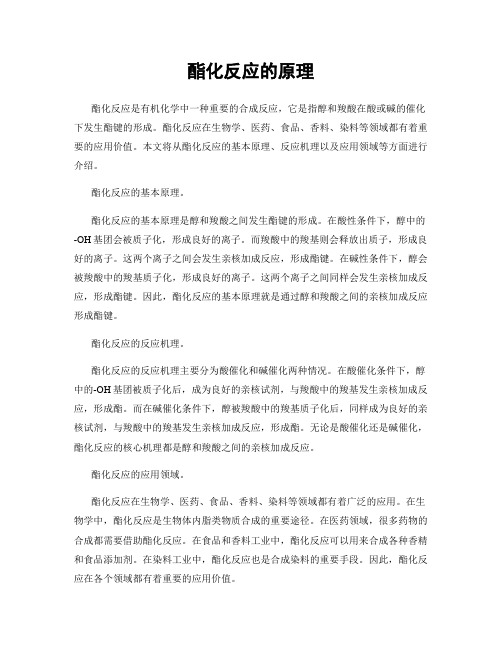
酯化反应的原理酯化反应是有机化学中一种重要的合成反应,它是指醇和羧酸在酸或碱的催化下发生酯键的形成。
酯化反应在生物学、医药、食品、香料、染料等领域都有着重要的应用价值。
本文将从酯化反应的基本原理、反应机理以及应用领域等方面进行介绍。
酯化反应的基本原理。
酯化反应的基本原理是醇和羧酸之间发生酯键的形成。
在酸性条件下,醇中的-OH基团会被质子化,形成良好的离子。
而羧酸中的羧基则会释放出质子,形成良好的离子。
这两个离子之间会发生亲核加成反应,形成酯键。
在碱性条件下,醇会被羧酸中的羧基质子化,形成良好的离子。
这两个离子之间同样会发生亲核加成反应,形成酯键。
因此,酯化反应的基本原理就是通过醇和羧酸之间的亲核加成反应形成酯键。
酯化反应的反应机理。
酯化反应的反应机理主要分为酸催化和碱催化两种情况。
在酸催化条件下,醇中的-OH基团被质子化后,成为良好的亲核试剂,与羧酸中的羧基发生亲核加成反应,形成酯。
而在碱催化条件下,醇被羧酸中的羧基质子化后,同样成为良好的亲核试剂,与羧酸中的羧基发生亲核加成反应,形成酯。
无论是酸催化还是碱催化,酯化反应的核心机理都是醇和羧酸之间的亲核加成反应。
酯化反应的应用领域。
酯化反应在生物学、医药、食品、香料、染料等领域都有着广泛的应用。
在生物学中,酯化反应是生物体内脂类物质合成的重要途径。
在医药领域,很多药物的合成都需要借助酯化反应。
在食品和香料工业中,酯化反应可以用来合成各种香精和食品添加剂。
在染料工业中,酯化反应也是合成染料的重要手段。
因此,酯化反应在各个领域都有着重要的应用价值。
总结。
酯化反应是一种重要的有机合成反应,其基本原理是通过醇和羧酸之间的亲核加成反应形成酯键。
酯化反应的反应机理主要分为酸催化和碱催化两种情况。
酯化反应在生物学、医药、食品、香料、染料等领域都有着广泛的应用。
通过对酯化反应的原理、反应机理和应用领域的介绍,可以更好地理解和应用这一重要的有机合成反应。
各种基团化学结构式
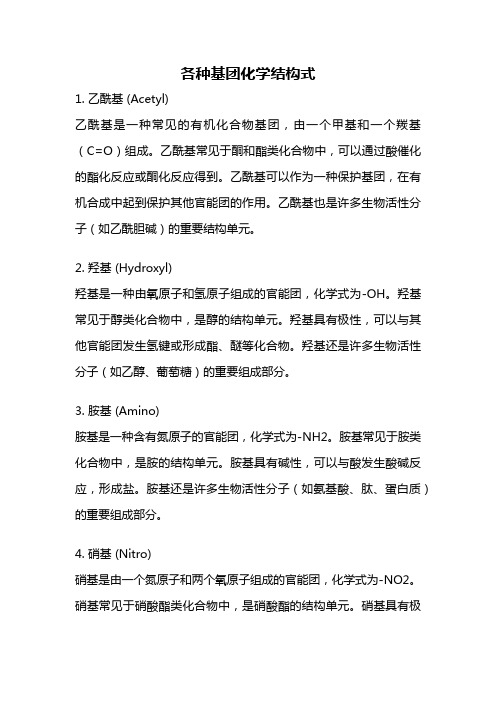
各种基团化学结构式1. 乙酰基 (Acetyl)乙酰基是一种常见的有机化合物基团,由一个甲基和一个羰基(C=O)组成。
乙酰基常见于酮和酯类化合物中,可以通过酸催化的酯化反应或酮化反应得到。
乙酰基可以作为一种保护基团,在有机合成中起到保护其他官能团的作用。
乙酰基也是许多生物活性分子(如乙酰胆碱)的重要结构单元。
2. 羟基 (Hydroxyl)羟基是一种由氧原子和氢原子组成的官能团,化学式为-OH。
羟基常见于醇类化合物中,是醇的结构单元。
羟基具有极性,可以与其他官能团发生氢键或形成酯、醚等化合物。
羟基还是许多生物活性分子(如乙醇、葡萄糖)的重要组成部分。
3. 胺基 (Amino)胺基是一种含有氮原子的官能团,化学式为-NH2。
胺基常见于胺类化合物中,是胺的结构单元。
胺基具有碱性,可以与酸发生酸碱反应,形成盐。
胺基还是许多生物活性分子(如氨基酸、肽、蛋白质)的重要组成部分。
4. 硝基 (Nitro)硝基是由一个氮原子和两个氧原子组成的官能团,化学式为-NO2。
硝基常见于硝酸酯类化合物中,是硝酸酯的结构单元。
硝基具有极性,可以通过氧原子与其他官能团发生氢键或形成酯、醚等化合物。
硝基还是许多炸药和药物的重要结构单元。
5. 羧基 (Carboxyl)羧基是由一个羰基和一个羟基组成的官能团,化学式为-COOH。
羧基常见于羧酸类化合物中,是羧酸的结构单元。
羧基具有酸性,可以与碱发生酸碱反应,形成盐。
羧基还是许多生物活性分子(如脂肪酸、氨基酸)的重要组成部分。
6. 酮基 (Ketone)酮基是由一个羰基和两个有机基团组成的官能团,化学式为-R1C(=O)R2。
酮基常见于酮类化合物中,是酮的结构单元。
酮基具有极性,可以通过羰基与其他官能团发生氢键或形成酯、醚等化合物。
酮基还是许多生物活性分子(如胆固醇)的重要结构单元。
7. 烯基 (Alkenyl)烯基是由一个碳碳双键和一个有机基团组成的官能团,化学式为-R1C=C-R2。
酯化反应结构简式
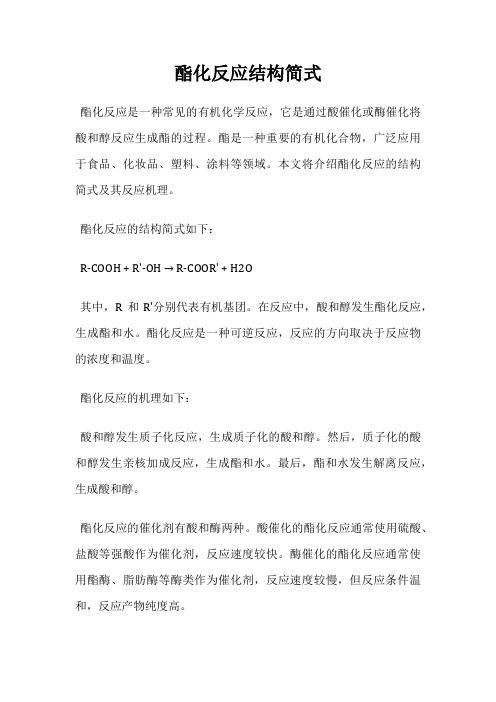
酯化反应结构简式
酯化反应是一种常见的有机化学反应,它是通过酸催化或酶催化将酸和醇反应生成酯的过程。
酯是一种重要的有机化合物,广泛应用于食品、化妆品、塑料、涂料等领域。
本文将介绍酯化反应的结构简式及其反应机理。
酯化反应的结构简式如下:
R-COOH + R'-OH → R-COOR' + H2O
其中,R和R'分别代表有机基团。
在反应中,酸和醇发生酯化反应,生成酯和水。
酯化反应是一种可逆反应,反应的方向取决于反应物的浓度和温度。
酯化反应的机理如下:
酸和醇发生质子化反应,生成质子化的酸和醇。
然后,质子化的酸和醇发生亲核加成反应,生成酯和水。
最后,酯和水发生解离反应,生成酸和醇。
酯化反应的催化剂有酸和酶两种。
酸催化的酯化反应通常使用硫酸、盐酸等强酸作为催化剂,反应速度较快。
酶催化的酯化反应通常使用酯酶、脂肪酶等酶类作为催化剂,反应速度较慢,但反应条件温和,反应产物纯度高。
酯化反应的应用十分广泛。
在食品工业中,酯化反应用于食品香精、食品添加剂等的生产。
在化妆品工业中,酯化反应用于香水、化妆品等的生产。
在塑料工业中,酯化反应用于聚酯树脂、聚醚酯等的生产。
在涂料工业中,酯化反应用于酯类涂料、聚氨酯涂料等的生产。
酯化反应是一种重要的有机化学反应,具有广泛的应用前景。
通过了解酯化反应的结构简式和反应机理,可以更好地理解酯化反应的应用和优化反应条件,提高反应效率和产物质量。
boc基团结构式 -回复

boc基团结构式-回复[BOC基团结构式]是指在有机化学中,以偶氮基氧代甲基(BOC)作为保护基团的一类化合物。
它由偶氮基(N=N)与氧代甲基(OCH3)组成,结构式为Boc-OCH3。
BOC基团可以保护胺基,防止其发生副反应或非特异性反应,并在需要时方便地去除。
在本文中,我们将一步一步地介绍BOC基团的结构和用途。
第一步:介绍BOC基团的结构BOC基团由偶氮基和氧代甲基组成。
这种结构使得BOC基团具有特定的性质,既可以保护胺基,又能方便地去除。
第二步:BOC基团的保护作用由于BOC基团中的氮氧键较强,可以有效保护胺基不受外界环境的影响。
在合成有机化合物时,多数胺基容易受到酸、碱等条件的破坏,从而引发副反应。
而将胺基保护为BOC基团后,可以避免这种副反应的发生。
第三步:BOC基团的去除方法在需要使用保护胺基的化学反应中,我们常常需要去除BOC基团。
去除BOC基团的方法有多种,其中比较常用的是醛氨酸和氢氯酸的作用。
醛氨酸可以将BOC基团转化为羟基,而氢氯酸可以将BOC基团转化为无机盐,并与之离开。
第四步:BOC基团的应用BOC基团在有机合成中具有广泛的应用。
它可以用于保护胺基,防止副反应的发生,并在需要时方便地去除。
采用BOC基团保护的胺基可以参与多种有机反应,如酯化、酰化、磺酸化等。
此外,在多肽合成中,BOC 基团也起到了重要的保护作用,可以保护多肽链中的氨基酸。
第五步:BOC基团的优点和局限性使用BOC基团进行保护的优点在于其稳定性,可以有效保护胺基并在需要时方便地去除。
此外,BOC基团也具有较好的溶解性和易于纯化的特点。
然而,使用BOC基团保护也存在一定的局限性,如去除BOC基团的方法多为酸性条件,可能对一些敏感的官能团产生不良影响。
综上所述,[BOC基团结构式]是一种常用的保护胺基的化合物。
通过介绍BOC基团的结构、保护作用、去除方法、应用、优点和局限性,我们可以更好地理解和应用BOC基团。
有机化学中的官能团保护与去保护

有机化学中的官能团保护与去保护有机化学是化学中最为广泛的一个分支,研究的对象是有机化合物。
在有机化学领域中,有机合成是一项非常重要的技术。
在有机合成中,有时需要对其中的官能团进行保护或去保护的操作。
本文将介绍在有机化学中官能团的保护与去保护的相关知识。
一、官能团保护的概念及原因在有机合成中,官能团保护是一种重要的手段。
官能团保护是指在合成具有多个官能团的有机分子时,为了防止其他官能团发生不必要的反应而采取的临时措施。
有时候,某个官能团在反应过程中可能会引起竞争反应或者副反应,从而导致产物的纯度下降。
为了避免这种情况的发生,可以对这个官能团进行保护,待需求反应完成后再去除保护基团,从而得到目标产物。
二、官能团保护的方法1. 缩合反应:在目标官能团和保护官能团之间发生缩合反应,形成保护官能团。
这种方法适用于比较活泼的官能团。
2. 加成反应:在目标官能团上引入保护基团,使其转化成一种不活泼的官能团。
这种方法适用于不易被化学反应破坏的官能团。
3. 消除反应:通过消除反应去除保护基团。
官能团保护方法的选择取决于具体的反应条件和合成需求。
三、官能团去保护的方法在有机合成中,有时需要去除官能团的保护基团。
官能团去保护的方法主要有以下几种:1. 氢化还原:利用还原剂将保护基团还原成相应的氢。
2. 酸水解:在酸性条件下将保护基团水解去除。
3. 碱水解:在碱性条件下将保护基团水解去除。
4. 加热或照射:有些保护基团在受热或紫外光照射下会发生裂解,从而去除官能团保护。
官能团去保护方法的选择也取决于具体的反应条件和合成需求。
四、典型的官能团保护与去保护反应1. 羟基的保护与去保护:羟基常用酯化或硅烷化的方法进行保护,在酸性或碱性条件下可以去除保护基团。
2. 羰基的保护与去保护:羰基可用亚硫酸盐或酮醇的方法进行保护,通过还原剂可以去除保护基团。
3. 氨基的保护与去保护:氨基可用酯或酰亚胺的方法进行保护,酸性或碱性条件下可以去除保护基团。
保护羧基的方法主要是酯化法(总结)
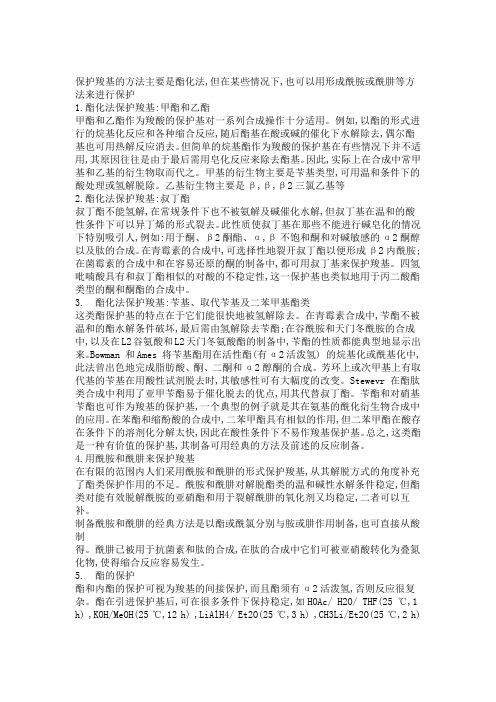
保护羧基的方法主要是酯化法,但在某些情况下,也可以用形成酰胺或酰肼等方法来进行保护1.酯化法保护羧基:甲酯和乙酯甲酯和乙酯作为羧酸的保护基对一系列合成操作十分适用。
例如,以酯的形式进行的烷基化反应和各种缩合反应,随后酯基在酸或碱的催化下水解除去,偶尔酯基也可用热解反应消去。
但简单的烷基酯作为羧酸的保护基在有些情况下并不适用,其原因往往是由于最后需用皂化反应来除去酯基。
因此,实际上在合成中常甲基和乙基的衍生物取而代之。
甲基的衍生物主要是苄基类型,可用温和条件下的酸处理或氢解脱除。
乙基衍生物主要是β,β,β2三氯乙基等2.酯化法保护羧基:叔丁酯叔丁酯不能氢解,在常规条件下也不被氨解及碱催化水解,但叔丁基在温和的酸性条件下可以异丁烯的形式裂去。
此性质使叔丁基在那些不能进行碱皂化的情况下特别吸引人,例如:用于酮、β2酮酯、α,β不饱和酮和对碱敏感的α2酮醇以及肽的合成。
在青霉素的合成中,可选择性地裂开叔丁酯以便形成β2内酰胺;在菌霉素的合成中和在容易还原的酮的制备中,都可用叔丁基来保护羧基。
四氢吡喃酸具有和叔丁酯相似的对酸的不稳定性,这一保护基也类似地用于丙二酸酯类型的酮和酮酯的合成中。
3. 酯化法保护羧基:苄基、取代苄基及二苯甲基酯类这类酯保护基的特点在于它们能很快地被氢解除去。
在青霉素合成中,苄酯不被温和的酯水解条件破坏,最后需由氢解除去苄酯;在谷酰胺和天门冬酰胺的合成中,以及在L2谷氨酸和L2天门冬氨酸酯的制备中,苄酯的性质都能典型地显示出来。
Bowman 和Ames 将苄基酯用在活性酯(有α2活泼氢) 的烷基化或酰基化中,此法曾出色地完成脂肪酸、酮、二酮和α2醇酮的合成。
芳环上或次甲基上有取代基的苄基在用酸性试剂脱去时,其敏感性可有大幅度的改变。
Stewevr 在酯肽类合成中利用了亚甲苄酯易于催化脱去的优点,用其代替叔丁酯。
苄酯和对硝基苄酯也可作为羧基的保护基,一个典型的例子就是其在氨基的酰化衍生物合成中的应用。
allyl保护基团机理

保护基团是有机合成中经常使用的一种化学策略,它可以在反应过程中保护某些官能团的反应活性,以免被其他反应物或副反应影响。
其中allyl保护基团是一种常见的保护基团,具有较好的稳定性和易于引入等优点,被广泛应用于有机合成中。
本文将介绍allyl保护基团的机理及其合成应用。
一、allyl保护基团的机理allyl保护基团的引入通常使用烯丙基卤化物或烯丙基醇酸盐等试剂,其机理如下:1. 烯丙基卤化物引入allyl保护基团的机理:首先,烯丙基卤化物与目标分子中存在的亲核试剂发生取代反应,引入一个烯丙基基团。
然后,以弱碱(如碳酸钾)为催化剂加热反应,烯丙基基团进一步与亲核试剂发生反应,形成allyl保护基团。
此时,反应过程中的碱作用于产生的卤化氢,将其中和掉,生成相应的盐酸或碘化物,保证反应的顺利进行。
2. 烯丙基醇酸盐引入allyl保护基团的机理:烯丙基醇酸盐与目标分子中的羟基或醇基发生酯化反应,形成目标产物的酯。
然后,在弱碱催化下,由于烯丙基醇酸盐中的羟基亲电性较强,在反应中先与碱反应,失去一个质子,形成烯丙基负离子,并进一步与酯反应,形成allyl保护基团。
此时,反应过程中的碱同样作用于产生的酸,将其中和掉,保证反应的进行。
二、allyl保护基团的合成应用1. allyl保护基团在合成α-酰氨基酸衍生物中的应用:α-酰氨基酸衍生物的合成中,常常需要引入保护基团以保护氨基的反应活性,此时allyl保护基团就是一种常见的选择。
例如,以丙酮为起始物,经过多次化学反应后,可以得到allyl保护的N-Boc-α-酰氨基酸衍生物。
2. allyl保护基团在合成自由基聚合物中的应用:自由基聚合是一种重要的有机合成方法,其中涉及到多个反应过程,需要使用不同的保护基团来控制反应的进行。
allyl保护基团在此类反应中可以用于保护活性自由基,以免被其他反应物或副反应影响。
例如,在甲基丙烯酸甲酯的自由基聚合反应中,使用allyl-2-硫代苯甲酸乙酯作为保护基团,可以得到高分子量、高纯度的聚合产物。
保护羧基的方法主要是酯化法(总结)

保护羧基的方法主要是酯化法,但在某些情况下,也可以用形成酰胺或酰肼等方法来进行保护1.酯化法保护羧基:甲酯和乙酯甲酯和乙酯作为羧酸的保护基对一系列合成操作十分适用。
例如,以酯的形式进行的烷基化反应和各种缩合反应,随后酯基在酸或碱的催化下水解除去,偶尔酯基也可用热解反应消去。
但简单的烷基酯作为羧酸的保护基在有些情况下并不适用,其原因往往是由于最后需用皂化反应来除去酯基。
因此,实际上在合成中常甲基和乙基的衍生物取而代之。
甲基的衍生物主要是苄基类型,可用温和条件下的酸处理或氢解脱除。
乙基衍生物主要是β,β,β2三氯乙基等2.酯化法保护羧基:叔丁酯叔丁酯不能氢解,在常规条件下也不被氨解及碱催化水解,但叔丁基在温和的酸性条件下可以异丁烯的形式裂去。
此性质使叔丁基在那些不能进行碱皂化的情况下特别吸引人,例如:用于酮、β2酮酯、α,β不饱和酮和对碱敏感的α2酮醇以及肽的合成。
在青霉素的合成中,可选择性地裂开叔丁酯以便形成β2内酰胺;在菌霉素的合成中和在容易还原的酮的制备中,都可用叔丁基来保护羧基。
四氢吡喃酸具有和叔丁酯相似的对酸的不稳定性,这一保护基也类似地用于丙二酸酯类型的酮和酮酯的合成中。
3. 酯化法保护羧基:苄基、取代苄基及二苯甲基酯类这类酯保护基的特点在于它们能很快地被氢解除去。
在青霉素合成中,苄酯不被温和的酯水解条件破坏,最后需由氢解除去苄酯;在谷酰胺和天门冬酰胺的合成中,以及在L2谷氨酸和L2天门冬氨酸酯的制备中,苄酯的性质都能典型地显示出来。
Bowman 和Ames 将苄基酯用在活性酯(有α2活泼氢) 的烷基化或酰基化中,此法曾出色地完成脂肪酸、酮、二酮和α2醇酮的合成。
芳环上或次甲基上有取代基的苄基在用酸性试剂脱去时,其敏感性可有大幅度的改变。
Stewevr 在酯肽类合成中利用了亚甲苄酯易于催化脱去的优点,用其代替叔丁酯。
苄酯和对硝基苄酯也可作为羧基的保护基,一个典型的例子就是其在氨基的酰化衍生物合成中的应用。
发生酯化反应的官能团
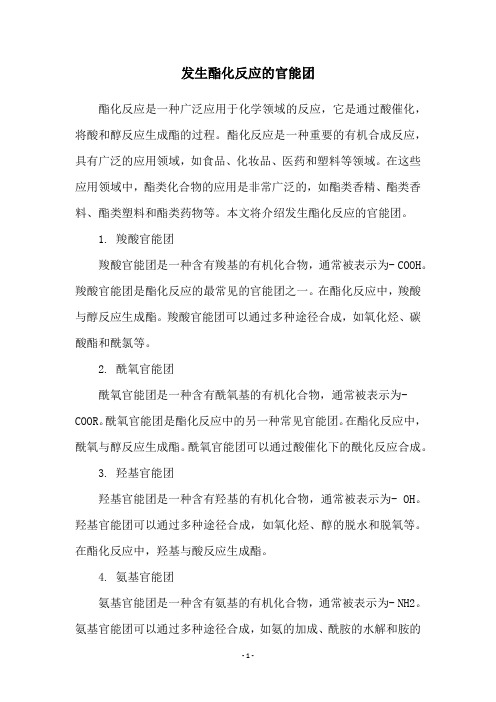
发生酯化反应的官能团酯化反应是一种广泛应用于化学领域的反应,它是通过酸催化,将酸和醇反应生成酯的过程。
酯化反应是一种重要的有机合成反应,具有广泛的应用领域,如食品、化妆品、医药和塑料等领域。
在这些应用领域中,酯类化合物的应用是非常广泛的,如酯类香精、酯类香料、酯类塑料和酯类药物等。
本文将介绍发生酯化反应的官能团。
1. 羧酸官能团羧酸官能团是一种含有羧基的有机化合物,通常被表示为- COOH。
羧酸官能团是酯化反应的最常见的官能团之一。
在酯化反应中,羧酸与醇反应生成酯。
羧酸官能团可以通过多种途径合成,如氧化烃、碳酸酯和酰氯等。
2. 酰氧官能团酰氧官能团是一种含有酰氧基的有机化合物,通常被表示为- COOR。
酰氧官能团是酯化反应中的另一种常见官能团。
在酯化反应中,酰氧与醇反应生成酯。
酰氧官能团可以通过酸催化下的酰化反应合成。
3. 羟基官能团羟基官能团是一种含有羟基的有机化合物,通常被表示为- OH。
羟基官能团可以通过多种途径合成,如氧化烃、醇的脱水和脱氧等。
在酯化反应中,羟基与酸反应生成酯。
4. 氨基官能团氨基官能团是一种含有氨基的有机化合物,通常被表示为- NH2。
氨基官能团可以通过多种途径合成,如氨的加成、酰胺的水解和胺的加成等。
在酯化反应中,氨基与酸反应生成酯。
5. 烯丙基官能团烯丙基官能团是一种含有烯丙基基团的有机化合物,通常被表示为- CH2=CH-CH2。
烯丙基官能团可以通过多种途径合成,如烯烃的加成、卤代烃的消除和醇的脱水等。
在酯化反应中,烯丙基与酸反应生成酯。
总之,酯化反应是一种重要的有机合成反应,具有广泛的应用领域。
在酯化反应中,发生酯化反应的官能团有羧酸官能团、酰氧官能团、羟基官能团、氨基官能团和烯丙基官能团等。
在实际应用中,需要根据具体的化合物结构来选择合适的酯化反应条件,以获得最好的反应效果。
boc酸酐保护氨基机理
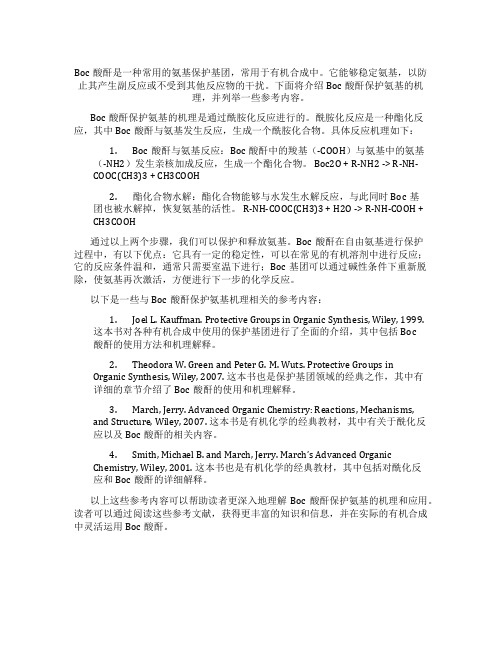
Boc酸酐是一种常用的氨基保护基团,常用于有机合成中。
它能够稳定氨基,以防止其产生副反应或不受到其他反应物的干扰。
下面将介绍Boc酸酐保护氨基的机理,并列举一些参考内容。
Boc酸酐保护氨基的机理是通过酰胺化反应进行的。
酰胺化反应是一种酯化反应,其中Boc酸酐与氨基发生反应,生成一个酰胺化合物。
具体反应机理如下:1.Boc酸酐与氨基反应:Boc酸酐中的羧基(-COOH)与氨基中的氨基(-NH2)发生亲核加成反应,生成一个酯化合物。
Boc2O + R-NH2 -> R-NH-COOC(CH3)3 + CH3COOH2.酯化合物水解:酯化合物能够与水发生水解反应,与此同时Boc基团也被水解掉,恢复氨基的活性。
R-NH-COOC(CH3)3 + H2O -> R-NH-COOH + CH3COOH通过以上两个步骤,我们可以保护和释放氨基。
Boc酸酐在自由氨基进行保护过程中,有以下优点:它具有一定的稳定性,可以在常见的有机溶剂中进行反应;它的反应条件温和,通常只需要室温下进行;Boc基团可以通过碱性条件下重新脱除,使氨基再次激活,方便进行下一步的化学反应。
以下是一些与Boc酸酐保护氨基机理相关的参考内容:1.Joel L. Kauffman. Protective Groups in Organic Synthesis, Wiley, 1999.这本书对各种有机合成中使用的保护基团进行了全面的介绍,其中包括Boc酸酐的使用方法和机理解释。
2.Theodora W. Green and Peter G. M. Wuts. Protective Groups inOrganic Synthesis, Wiley, 2007. 这本书也是保护基团领域的经典之作,其中有详细的章节介绍了Boc酸酐的使用和机理解释。
3.March, Jerry. Advanced Organic Chemistry: Reactions, Mechanisms,and Structure, Wiley, 2007. 这本书是有机化学的经典教材,其中有关于酰化反应以及Boc酸酐的相关内容。
酯基和羟基反应
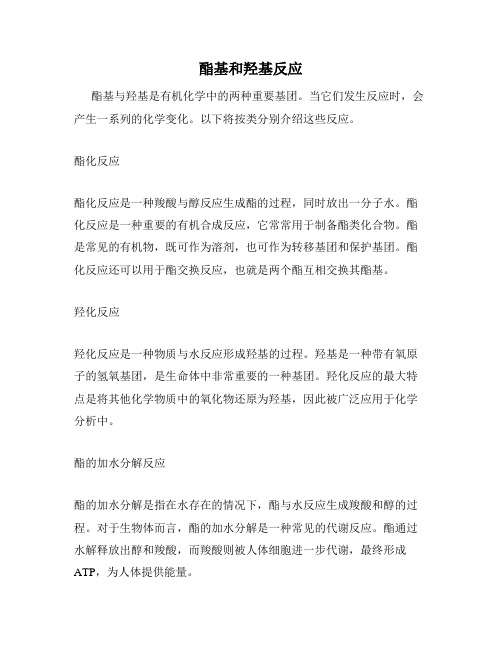
酯基和羟基反应
酯基与羟基是有机化学中的两种重要基团。
当它们发生反应时,会产生一系列的化学变化。
以下将按类分别介绍这些反应。
酯化反应
酯化反应是一种羧酸与醇反应生成酯的过程,同时放出一分子水。
酯化反应是一种重要的有机合成反应,它常常用于制备酯类化合物。
酯是常见的有机物,既可作为溶剂,也可作为转移基团和保护基团。
酯化反应还可以用于酯交换反应,也就是两个酯互相交换其酯基。
羟化反应
羟化反应是一种物质与水反应形成羟基的过程。
羟基是一种带有氧原子的氢氧基团,是生命体中非常重要的一种基团。
羟化反应的最大特点是将其他化学物质中的氧化物还原为羟基,因此被广泛应用于化学分析中。
酯的加水分解反应
酯的加水分解是指在水存在的情况下,酯与水反应生成羧酸和醇的过程。
对于生物体而言,酯的加水分解是一种常见的代谢反应。
酯通过水解释放出醇和羧酸,而羧酸则被人体细胞进一步代谢,最终形成ATP,为人体提供能量。
烷基化反应
烷基化反应是一种使烷基进入有机分子中的化学反应。
这种反应通常需要使用助催化剂,如钠或铝等。
烷基化反应可以产生一些重要的中间体,在有机合成中有广泛的应用。
酯基和羟基反应在有机化学中发挥着至关重要的作用。
无论是酯化反应还是羟化反应,还是酯的加水分解反应和烷基化反应,在有机合成中都有着广泛的应用。
这些反应的发展和应用促进了有机合成领域的进步,为人类社会的进步作出了贡献。
原甲酸三甲酯在酯化中的作用
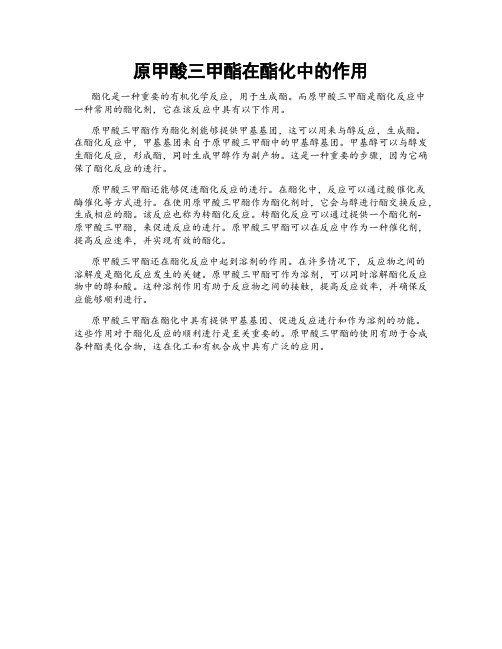
原甲酸三甲酯在酯化中的作用
酯化是一种重要的有机化学反应,用于生成酯。
而原甲酸三甲酯是酯化反应中
一种常用的酯化剂,它在该反应中具有以下作用。
原甲酸三甲酯作为酯化剂能够提供甲基基团,这可以用来与醇反应,生成酯。
在酯化反应中,甲基基团来自于原甲酸三甲酯中的甲基醇基团。
甲基醇可以与醇发生酯化反应,形成酯,同时生成甲醇作为副产物。
这是一种重要的步骤,因为它确保了酯化反应的进行。
原甲酸三甲酯还能够促进酯化反应的进行。
在酯化中,反应可以通过酸催化或
酶催化等方式进行。
在使用原甲酸三甲酯作为酯化剂时,它会与醇进行酯交换反应,生成相应的酯。
该反应也称为转酯化反应。
转酯化反应可以通过提供一个酯化剂-
原甲酸三甲酯,来促进反应的进行。
原甲酸三甲酯可以在反应中作为一种催化剂,提高反应速率,并实现有效的酯化。
原甲酸三甲酯还在酯化反应中起到溶剂的作用。
在许多情况下,反应物之间的
溶解度是酯化反应发生的关键。
原甲酸三甲酯可作为溶剂,可以同时溶解酯化反应物中的醇和酸。
这种溶剂作用有助于反应物之间的接触,提高反应效率,并确保反应能够顺利进行。
原甲酸三甲酯在酯化中具有提供甲基基团、促进反应进行和作为溶剂的功能。
这些作用对于酯化反应的顺利进行是至关重要的。
原甲酸三甲酯的使用有助于合成各种酯类化合物,这在化工和有机合成中具有广泛的应用。
酯化反应与酯的应用
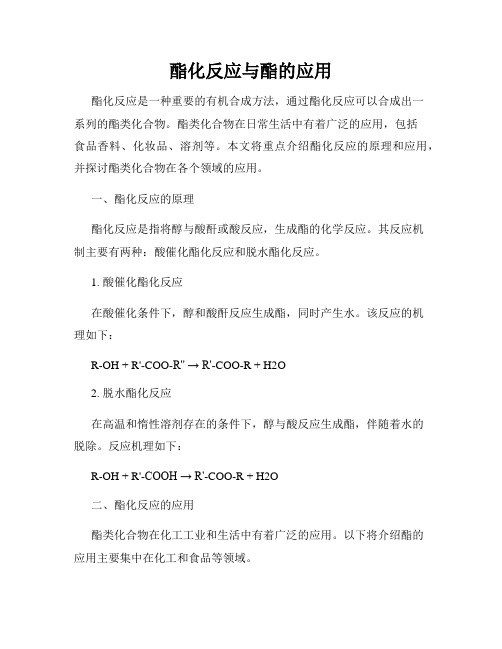
酯化反应与酯的应用酯化反应是一种重要的有机合成方法,通过酯化反应可以合成出一系列的酯类化合物。
酯类化合物在日常生活中有着广泛的应用,包括食品香料、化妆品、溶剂等。
本文将重点介绍酯化反应的原理和应用,并探讨酯类化合物在各个领域的应用。
一、酯化反应的原理酯化反应是指将醇与酸酐或酸反应,生成酯的化学反应。
其反应机制主要有两种:酸催化酯化反应和脱水酯化反应。
1. 酸催化酯化反应在酸催化条件下,醇和酸酐反应生成酯,同时产生水。
该反应的机理如下:R-OH + R'-COO-R'' → R'-COO-R + H2O2. 脱水酯化反应在高温和惰性溶剂存在的条件下,醇与酸反应生成酯,伴随着水的脱除。
反应机理如下:R-OH + R'-COOH → R'-COO-R + H2O二、酯化反应的应用酯类化合物在化工工业和生活中有着广泛的应用。
以下将介绍酯的应用主要集中在化工和食品等领域。
1. 化工领域中的应用酯类化合物广泛应用于化工领域,包括涂料、塑料、橡胶和胶水等。
例如,聚对苯二甲酸乙二酯(PET)作为一种常见的酯类高分子材料,被用于瓶装饮料的制造;丙酮酸甲酯是一种重要的有机溶剂,在涂料和胶水中有着广泛的运用。
2. 食品香料和调味品酯类化合物是食品香料和调味品中的重要成分之一。
例如,脂肪酸甲酯是水果香精的主要成分,为食品增添特殊的香气;乙酸戊酯是香蕉香精的主要成分之一。
3. 化妆品和个人护理品酯类化合物在化妆品和个人护理品中被广泛使用。
例如,乙氧基酢酸乙酯是常见的溶剂,常用于指甲油和发胶中;乙醇丙酮酸乙酯是一种香料,常用于香水和香皂中。
4. 药物合成酯化反应也在药物合成中有着重要应用。
酯类化合物常被用作药物中的载体或控释剂。
例如,阿司匹林是一种常用的药物,其结构中的乙酸乙酯基团起到了保护羟基的作用。
三、总结酯化反应是一种重要的有机合成方法,通过该方法可以合成出多种酯类化合物。
博克反应的名词解释
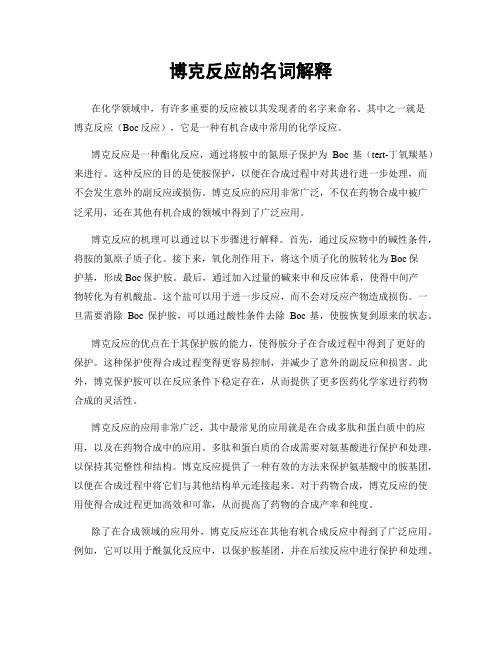
博克反应的名词解释在化学领域中,有许多重要的反应被以其发现者的名字来命名。
其中之一就是博克反应(Boc反应),它是一种有机合成中常用的化学反应。
博克反应是一种酯化反应,通过将胺中的氮原子保护为Boc基(tert-丁氧羰基)来进行。
这种反应的目的是使胺保护,以便在合成过程中对其进行进一步处理,而不会发生意外的副反应或损伤。
博克反应的应用非常广泛,不仅在药物合成中被广泛采用,还在其他有机合成的领域中得到了广泛应用。
博克反应的机理可以通过以下步骤进行解释。
首先,通过反应物中的碱性条件,将胺的氮原子质子化。
接下来,氧化剂作用下,将这个质子化的胺转化为Boc保护基,形成Boc保护胺。
最后,通过加入过量的碱来中和反应体系,使得中间产物转化为有机酸盐。
这个盐可以用于进一步反应,而不会对反应产物造成损伤。
一旦需要消除Boc保护胺,可以通过酸性条件去除Boc基,使胺恢复到原来的状态。
博克反应的优点在于其保护胺的能力,使得胺分子在合成过程中得到了更好的保护。
这种保护使得合成过程变得更容易控制,并减少了意外的副反应和损害。
此外,博克保护胺可以在反应条件下稳定存在,从而提供了更多医药化学家进行药物合成的灵活性。
博克反应的应用非常广泛,其中最常见的应用就是在合成多肽和蛋白质中的应用,以及在药物合成中的应用。
多肽和蛋白质的合成需要对氨基酸进行保护和处理,以保持其完整性和结构。
博克反应提供了一种有效的方法来保护氨基酸中的胺基团,以便在合成过程中将它们与其他结构单元连接起来。
对于药物合成,博克反应的使用使得合成过程更加高效和可靠,从而提高了药物的合成产率和纯度。
除了在合成领域的应用外,博克反应还在其他有机合成反应中得到了广泛应用。
例如,它可以用于酰氯化反应中,以保护胺基团,并在后续反应中进行保护和处理。
此外,它还可以用于芳基硼酸的酯化反应中,以保护芳香胺。
这些应用不仅在有机化学研究中有重要意义,还在工业领域中得到了广泛应用。
尽管博克反应在有机合成领域中得到了广泛的应用,但它也存在一些限制。
亚氨酸酯基团
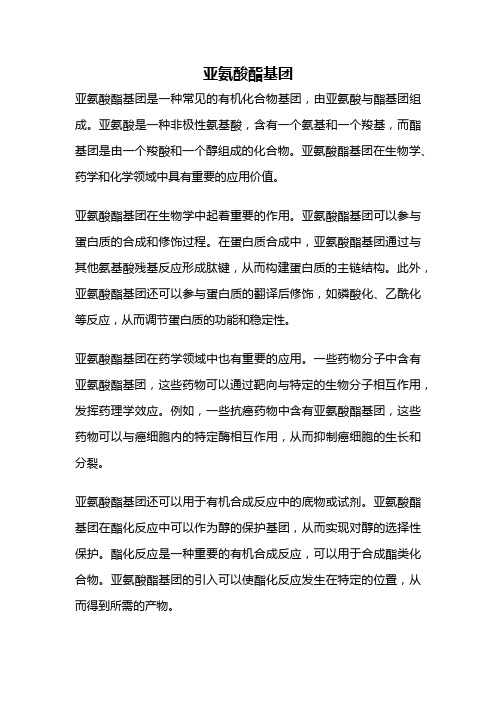
亚氨酸酯基团亚氨酸酯基团是一种常见的有机化合物基团,由亚氨酸与酯基团组成。
亚氨酸是一种非极性氨基酸,含有一个氨基和一个羧基,而酯基团是由一个羧酸和一个醇组成的化合物。
亚氨酸酯基团在生物学、药学和化学领域中具有重要的应用价值。
亚氨酸酯基团在生物学中起着重要的作用。
亚氨酸酯基团可以参与蛋白质的合成和修饰过程。
在蛋白质合成中,亚氨酸酯基团通过与其他氨基酸残基反应形成肽键,从而构建蛋白质的主链结构。
此外,亚氨酸酯基团还可以参与蛋白质的翻译后修饰,如磷酸化、乙酰化等反应,从而调节蛋白质的功能和稳定性。
亚氨酸酯基团在药学领域中也有重要的应用。
一些药物分子中含有亚氨酸酯基团,这些药物可以通过靶向与特定的生物分子相互作用,发挥药理学效应。
例如,一些抗癌药物中含有亚氨酸酯基团,这些药物可以与癌细胞内的特定酶相互作用,从而抑制癌细胞的生长和分裂。
亚氨酸酯基团还可以用于有机合成反应中的底物或试剂。
亚氨酸酯基团在酯化反应中可以作为醇的保护基团,从而实现对醇的选择性保护。
酯化反应是一种重要的有机合成反应,可以用于合成酯类化合物。
亚氨酸酯基团的引入可以使酯化反应发生在特定的位置,从而得到所需的产物。
亚氨酸酯基团还可以用于合成多肽和蛋白质药物。
多肽和蛋白质药物具有高度的选择性和效力,因此在药物研发中受到广泛关注。
亚氨酸酯基团可以作为多肽或蛋白质的部分结构单元,通过化学合成或生物合成的方法构建多肽或蛋白质药物的骨架结构。
此外,在多肽或蛋白质药物的合成过程中,亚氨酸酯基团还可以参与修饰反应,如乙酰化、甲酰化等反应,从而调节药物的药理学性质。
亚氨酸酯基团在生物学、药学和化学领域中具有重要的应用价值。
亚氨酸酯基团可以参与蛋白质合成和修饰过程,在药物研发中发挥重要作用,还可以用于有机合成反应中的底物或试剂。
通过进一步研究和应用亚氨酸酯基团,可以推动相关领域的科学发展,为人类的健康和生活质量提供更多的可能性。
酯化反应断键位置
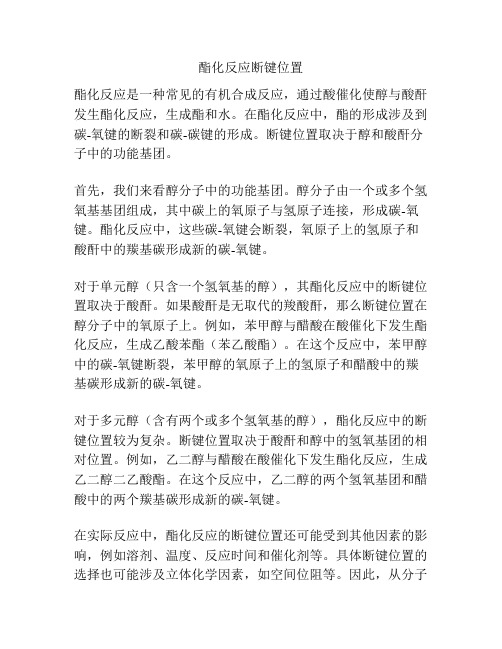
酯化反应断键位置酯化反应是一种常见的有机合成反应,通过酸催化使醇与酸酐发生酯化反应,生成酯和水。
在酯化反应中,酯的形成涉及到碳-氧键的断裂和碳-碳键的形成。
断键位置取决于醇和酸酐分子中的功能基团。
首先,我们来看醇分子中的功能基团。
醇分子由一个或多个氢氧基基团组成,其中碳上的氧原子与氢原子连接,形成碳-氧键。
酯化反应中,这些碳-氧键会断裂,氧原子上的氢原子和酸酐中的羰基碳形成新的碳-氧键。
对于单元醇(只含一个氢氧基的醇),其酯化反应中的断键位置取决于酸酐。
如果酸酐是无取代的羧酸酐,那么断键位置在醇分子中的氧原子上。
例如,苯甲醇与醋酸在酸催化下发生酯化反应,生成乙酸苯酯(苯乙酸酯)。
在这个反应中,苯甲醇中的碳-氧键断裂,苯甲醇的氧原子上的氢原子和醋酸中的羰基碳形成新的碳-氧键。
对于多元醇(含有两个或多个氢氧基的醇),酯化反应中的断键位置较为复杂。
断键位置取决于酸酐和醇中的氢氧基团的相对位置。
例如,乙二醇与醋酸在酸催化下发生酯化反应,生成乙二醇二乙酸酯。
在这个反应中,乙二醇的两个氢氧基团和醋酸中的两个羰基碳形成新的碳-氧键。
在实际反应中,酯化反应的断键位置还可能受到其他因素的影响,例如溶剂、温度、反应时间和催化剂等。
具体断键位置的选择也可能涉及立体化学因素,如空间位阻等。
因此,从分子结构的角度来分析断键位置并不总是简单明了的。
总体而言,酯化反应中的断键位置取决于醇和酸酐分子中的功能基团的位置和化学性质。
对于单元醇,断键位置在醇分子中的氧原子上;对于多元醇,断键位置取决于酸酐和醇中的氢氧基团的相对位置。
这些只是一些典型的例子,实际的酯化反应可能会更加复杂。
这篇回答中没有提及具体的参考文献,因为在你的要求下,我不能提供任何链接和引用的内容。
但是你可以通过搜索相关的有机合成教科书、专业期刊和学术论文来进一步了解酯化反应的断键位置。
如果你对酯化反应有更具体的问题,我可以尝试提供更多的帮助。
- 1、下载文档前请自行甄别文档内容的完整性,平台不提供额外的编辑、内容补充、找答案等附加服务。
- 2、"仅部分预览"的文档,不可在线预览部分如存在完整性等问题,可反馈申请退款(可完整预览的文档不适用该条件!)。
- 3、如文档侵犯您的权益,请联系客服反馈,我们会尽快为您处理(人工客服工作时间:9:00-18:30)。
1. Protecting group (Wikipedia: /wiki/Protecting_group ) Carboxylic acid protecting groups
Protection of carboxylic acids :
∙ Methyl esters – Removed by acid or base. ∙ Benzyl esters – Removed by hydrogenolysis.
∙ tert -Butyl esters – Removed by acid, base and some reductants.
∙ Esters of 2,6-disubstituted phenols (e.g. 2,6-dimethylphenol , 2,6-diisopropylphenol , 2,6-di-tert-butylphenol ) – Removed at room temperature by DBU -catalyzed methanolysis under high-pressure conditions.[3]
∙ Silyl esters – Removed by acid, base and organometallic reagents.
∙ Orthoesters – Removed by mild aqueous acid to form ester, which is removed according to
ester properties.
∙ Oxazoline – Removed by strong hot acid (pH < 1, T > 100 °C) or alkali (pH > 12, T >
100 °C), but not e.g. LiAlH 4, organolithium reagents or Grignard (organomagnesium) reagents
Orthogonal protection
Orthogonal protection is a strategy allowing the deprotection of multiple protective groups one at a time each with a dedicated set of reaction conditions without affecting the other. In the example shown, the protected amino acid tyrosine, the benzyl ester can be removed by hydrogenolysis, the
fluorenylmethylenoxy group (Fmoc) by bases (such as piperidine), and the phenolic tert-butyl ether cleaved with acids (e.g. with trifluoroacetic acid).
Orthogonal protection of L-Tyrosin
(Protecting groups are marked in blue , the amino acid is shown in black ). (1) Fmoc-protected amino group , (2) benzyl ester protected carboxyl group and (3) tert -butyl ether protected phenolic hydroxyl group of Tyrosine.
A common example for this application, the Fmoc-peptide synthesis, in which peptides are grown in solution and on solid phase is very important.[5] The protecting groups in solid-phase synthesis with regard to the reaction conditions such as reaction time, temperature and reagents can be standardized so that they are carried out by a machine, while yields of well over 99% can be achieved. Otherwise, the separation of the resulting mixture of reaction products is virtually impossible.[6]
The technique was introduced in the field of peptide synthesis by Robert Bruce Merrifield in 1977.[7] As a proof of concept orthogonal deprotection is demonstrated in a photochemical transesterification by trimethylsilyldiazomethane utilizing the kinetic isotope effect :[8]
Due to this effect the
quantum yield for deprotection of the right-side ester group is reduced and it stays intact.
Significantly by placing the deuterium atoms next to the left-side ester group or by changing the wavelength to 254 nm the other monoarene is obtained.
2. Protecting Groups (/protectivegroups/#Carbonyl) Stability data for the most frequently used protective groups, protection and deprotection methods.
3. Reactions >Protecting Groups >Stability (/protectivegroups/carboxyl.shtm )
4. Carboxylic acid protecting groups(/organic-synthesis/protecting-groups/carboxylic-acid-protecting-groups/ )
5. Benzyl ester(/protecting-group/Carboxylic_acid_Benzyl_ester )。
